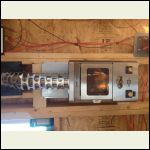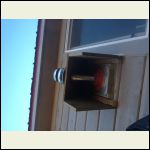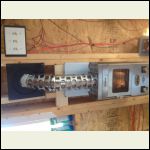|
| Author |
Message |
razmichael
Member
|
# Posted: 15 Sep 2013 04:36pm
Reply
Looking for some advice and suggestions. I posted in my build thread My Build that I installed a vented propane heater this weekend - or at least tried to. The heater is a Dickinson P1200 designed primarily for a boat. The chimney is a double pipe with the standard arrangement of the exhaust on the inside and the intake pipe on the outside. Between the two are a number of springs wrapped around the inner pipe to keep the two separated. As I need to bend the pipes I did my best (as per instructions) to keep the springs around the bend area. The chimney has a multiple cap on the end to separate the intake from the exhaust. After starting up the stove I was not at all comfortable with the outer pipe temperature - at least nothing I would like to put through the wall. I made a trip to the hardware store and picked up a metal dryer vent (not the foil type) and ran that up and through the wall. I used stove gasket spiraled up the outer chimney pipe to avoid it contacting the dryer vent. I still found that the vent was also getting hotter than I would like. It was sitting right down on top of the heater so no real air flow was possible up and out,
Any way, I intend to contact the manufacturer this week to see what they have to say but I thought I would ask if anyone has some suggestions and advice on how best to run this type of chimney out through a wall. If I use a third pipe of some type, how do I prevent cold air from coming in all the time the heater is off - how best to insulate around it etc. I'm thinking I might make up some sort or wire cage around the inside section or buying one that is available from the manufacturer (to keep hands off but use the heat) and then a solid external pipe through the wall but not sure how to terminate this outside and keep the weather outside.
|
|
rayyy
Member
|
# Posted: 15 Sep 2013 04:48pm
Reply
I know these type heaters use what is called B-vent double wall pipe.The special adaptor that goes through the wall is called a thimble.It gives the double wall pipe another inch of air space from any combustible.
|
|
razmichael
Member
|
# Posted: 15 Sep 2013 05:55pm - Edited by: razmichael
Reply
Thanks rayyy - I've been looking at these. The problem I'm going to have is the the heater chimney is only 3" and I have not been able to find a thimble this small - edit - did some searching with pellet stove accessories so may be able to find what I need. Do you pass the main pipe through the thimble?. Would it make sense to use a larger size thimble (4") to ensure a fit and then use high temp silicon to seal the inside and outside?
|
|
rayyy
Member
|
# Posted: 16 Sep 2013 04:58pm
Reply
Yes that would work.The whole idea is to assure that you have a 1 inch space or bigger between the b-vent doublewall pipe and anything combustable.
|
|
razmichael
Member
|
# Posted: 16 Sep 2013 05:29pm
Reply
I talked to the manufacturer and they concur with my plan to use a pellet stove thimble (3") to go through the wall (I realized that the current pipe is 2.5" only). As this normally just goes through a thin boat hull or wall, they suggest a 1/4" gap and directly into the cap on the other side and, although the pipe warms up, it does not have the same impact as through a thicker wall. As I need to go through 6 plus inches of wall the thimble will work fine. Thanks for the comments.
|
|
SandwichBear
Member
|
# Posted: 3 Dec 2013 02:42am
Reply
razmichael -
Did you get your Dickinson heater running acceptably? I am having the exact same issues with installing mine out the wall. I found that using the included 28" of chimney to exit through the wall works very poorly. I get paltry heat, and the stove makes soot. Test: failed.
I just ordered a 28" extension for $125. I plan to patch the hole that I drilled in my wall, and try to run the chimney as vertically as possible, through the roof.
There must be an inexpensive alternative to the $125 Dickinson flue pipe. I wonder if a 1.5" steel tube inside a 2.5" steel tube would do the same thing - they could be spaced apart with the four springs from the original chimney. If a thin-walled steel tube with a snug fitting I.D. could be found, I don't see why it wouldn't work. Rust, maybe?
A single straight length of pipe would look pretty cool, I think. Can't get more simple or vertical than that.
|
|
razmichael
Member
|
# Posted: 3 Dec 2013 07:41am
Reply
Running well (although limited experience in extended use). I used the 10" extension not a second 28" and gently bent it at an angle through the wall and then slightly up to the cap. I used a Duravent_3PVP-WT thimble (about $53cnd) to go through the wall. As I mentioned above, with talking to the manufacturer, the normal install through a boat hull just needs a 1/4 gap but when going through a cabin wall more clearance is needed (thus the thimble). I was not comfortable with the supplied springs being okay to keep the two pipes apart through the bend so picked us some extra ones at lowes (you can order them from dickinson). You need to make sure you have a good airflow between the two pipes for safety and to provide enough air intake. Connecting the pipes to the unit is tricky. I used a small amount of gasket sealant to ensure a good seal once I slipped the pipes on. The whole thing is very finicky!
IMG_2667.JPG
| 
IMG_2702.JPG
| 
IMG_2662.JPG
|  |
|
|
SandwichBear
Member
|
# Posted: 3 Dec 2013 12:58pm
Reply
Glad the Dickinson is working out for you. My initial install is novice and unacceptable - the tight bend with the supplied 28" pipe is no good. The instructions seem to indicate that this is fine, and my first correspondence with Dickinson's tech support seemed to validate this. In my experience - it's not okay.
I bought the extension pipe, and hopefully a nearly vertical installation yields different results. I want my tiny 12'x8' to be toasty when it's in the 20's outside this winter. As it stands, the heater couldn't adequately warm the place up from the mid-30's after burning for 3 hours. And it was very dirty.
Based on others' experiences, it should be able to keep my place heated pretty easily. If not, I'm selling it and getting an 18,000 BTU direct vent wall-mount heater. I would be sad to lose the little fireplace look, but a comfortable temperature is of primary importance.
|
|
|
razmichael
Member
|
# Posted: 3 Dec 2013 01:08pm
Reply
Hopefully it will work out for you - the straighter the chimney the better. Despite going out the wall I kept the pipe fairly straight. Keep in mind that the p1200 is only 9,700 btu on high so you may not find it adequate depending on insulation etc. I'm not planning on winter use just three seasons so I figured the Dickinson will work and look nice as well. If I was planning on winter then I would add a small wood stove. As it is, I have a big Kerosene heater handy in case I need to get the temperature up quickly and then maintain with the dickinson.
|
|
SandwichBear
Member
|
# Posted: 3 Dec 2013 01:43pm
Reply
Good points. I guess I'll just have to patch one hole and drill another one before I know whether I will ultimately be satisfied with this heater or not. Nobody said building a house would be easy.
|
|
razmichael
Member
|
# Posted: 3 Dec 2013 01:51pm
Reply
I just noticed in your other post that you have the P9000 - that is 7,500 BTU only - will that be enough to meet your needs by itself?
|
|
SandwichBear
Member
|
# Posted: 3 Dec 2013 01:55pm
Reply
Probably not. But that's the $875 question. I'm prepared to drill a hole in my roof, but I'm also thinking about resale value of a thrice-lit marine stove.
|
|
SandwichBear
Member
|
# Posted: 3 Dec 2013 02:00pm
Reply
Or - (I have exactly zero experience with this) - maybe I can get a supplemental heater just to get the temperature up.
If I got a heater to help get the temperature where I want it, perhaps the Dickinson would be powerful enough to maintain that temperature.
I'm not in a terribly harsh climate, but we do get down into the 20s and below. I don't know if I want to scrap my dreams of Dickinson just because of a couple weeks worth of extra-cold days.
These are hard choices for me, and I can't draw on any experience for guidance.
|
|
creeky
Member
|
# Posted: 3 Dec 2013 06:20pm
Reply
Can I ask why you don't just terminate at the outside wall? The install manual says a horizontal termination is acceptable.
One bend. Terminate. Done. No?
|
|
SandwichBear
Member
|
# Posted: 3 Dec 2013 06:47pm
Reply
Terminating after a single 90 degree bend gives me terrible results. The manual claims it is okay. I contacted Dickinson, and was told that it was acceptable. My test resulted in soot and not much heat. I contacted Dickinson again, and this time was told that vertical chimney installations are much better - more efficient, hotter, less soot. Further research - lots of forum threads, articles, and manuals - seems to confirm this. Vertical is better.
How much better? I don't know. I think it's a "try it and see" deal. One thing is sure: it's gotta be better than my tight 28-inch-long 90 degree bend.
|
|
MtnDon
Member
|
# Posted: 3 Dec 2013 07:04pm
Reply
I believe a straight run vertical would be vastly superior to anything with a bend. Some wood stoves have a terrible time of it when the chimney exits through a wall. Of course then there are 2 bends too. But if Dickinson also states the overall length should be no more than 56 inches how can a straight pipe be used in a cabin? I think if it win't work out the wall it won't work at all in your installation.
Are you using the fan?
Another Question. What is your altitude? Elevations over 2000 feet often need changes to the gas orifice. At least they do with the heaters meant for home/cabin use.
|
|
SandwichBear
Member
|
# Posted: 3 Dec 2013 07:14pm
Reply
I'm at 400 feet above sea level. Yup... only two zeros. I'm hoping that going from 28" with a tight bend to 56" with no bends makes a big difference. The guy from Dickinson didn't seem terribly impressed with my installation, in spite of the fact that it seems kosher with the manual's suggestions.
|
|
MtnDon
Member
|
# Posted: 3 Dec 2013 09:08pm
Reply
I'm thinking that the exhaust flue is marginally sized. That is why the length is restricted to 56" total. Too much friction and resulting turbulence with the air on the tube wall.
I have seen an installation of this heater (9K model) in a cargo trailer converted for camping use. I believe that used just the 28" tube out the trailer wall.
|
|
razmichael
Member
|
# Posted: 3 Dec 2013 09:52pm
Reply
As I mentioned, I added only 10" for 36 total so I had the length to only slightly bend it to run at an angle through the wall (2x6 plus siding) and then a slight bend up once outside but not back to vertical. Only guessing but not much more than 40 degrees then back 20. This made it a bit trickier to mount the thimble but kept the run as straight as possible.
|
|
|

